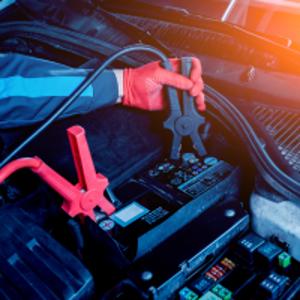
The Role of the Battery in Modern Vehicles
Regardless of the type of battery, its primary task is to provide electrical energy to the starter and support the vehicle's electrical systems. The battery fulfills several functions in the vehicle, some of which are not even known to professionals.
Contrary to popular belief, the car battery is not only used to start the engine but also continuously supplies the vehicle’s electrical systems with power, ensuring the reliable operation of the vehicle. The battery performs several key functions, without which the vehicle would not function properly:
Powering the Starter Motor
The primary function of the battery is to start the vehicle's engine. When we turn the key or press the start button, the battery provides a large amount of energy to the starter motor, which cranks the internal combustion engine. This large surge of current can quickly discharge the battery, but once the engine is running, the alternator recharges the consumed energy.
Operating Electrical Systems When the Engine is Off
The car battery also powers the electrical systems when the engine is not running. These include systems such as lighting, radio, power windows, central locking, alarm system, or the onboard computer. These systems have a low power consumption, so the battery can supply energy over a long period when the vehicle is not in use.
Voltage Stabilization
The electrical systems of the car are sensitive to voltage fluctuations, which can damage the electronics. In this case, the battery acts as a voltage stabilizer, compensating for the voltage fluctuations generated by the alternator and ensuring that the systems receive a steady voltage.
Power Supply in Start-Stop Systems
More and more modern vehicles are equipped with a start-stop system that shuts off the engine, for example, in traffic jams or at traffic lights, to save fuel. Such systems place particularly high demands on the battery, as the engine must be restarted frequently while the electrical systems continue to operate.
Different Types of Batteries
Since the battery is such an essential part of the car, it is extremely important which battery is installed in the vehicle. Depending on which vehicle the battery is intended for, the specifications can vary greatly. So, let's take a look at the comparison of the three most common categories: scooter batteries, truck batteries, and car batteries from a technical perspective!
The Best Battery: Size and Capacity
- Scooter batteries are typically smaller because motorcycles require much less power. A motorcycle battery typically has a capacity of 6-12 Ah, while the starting current is usually between 100-300 A.
- Car batteries are larger and have more capacity (50-100 Ah). They provide more power for the electrical systems and the car's starter. The starting current ranges from 400-600 A.
- Truck batteries are the largest, as trucks have high power requirements, requiring a capacity of over 100 Ah and a starting current of over 1000 A.
The Voltage of Motorcycle Batteries
Motorcycles typically use 12V batteries, although some smaller models have a 6V system.
Passenger cars are almost always equipped with a 12V battery, which is sufficient to power various electrical systems and the starter motor.
Trucks usually use 24V systems, where two 12V batteries are connected in series to ensure higher starting power.
Battery Lifespan
Motorcycle batteries, including batteries for electric scooters, often have a shorter lifespan due to their smaller capacity and frequent discharge cycles, as motorcycles are often used seasonally.
The lifespan of a car battery is typically 4-6 years, provided it is regularly maintained and used under optimal conditions.
Truck batteries can have a longer lifespan, but since they operate under harsher conditions (higher loads, frequent long-distance use), they are often more heavily stressed.
The Best Battery Types for Different Environments
Motorcycle batteries are lighter and more compact to meet the limited space requirements of the vehicle.
For passenger cars, the battery must be resistant to weather conditions and capable of supporting numerous electrical devices in modern cars.
Truck batteries are more robust, as they are designed for longer use and higher power consumption.
What Are the Most Important Factors When Buying a New Battery?
When selecting the right car battery, it is important to consider the size and type so that it fits the vehicle. The capacity (Ah) and cold cranking amperage (CCA) are crucial to ensure the engine starts reliably in all conditions.
Reputable manufacturers offer high-quality products with longer lifespans and better warranties. Additionally, maintenance requirements and the right price-performance ratio are important factors to consider.
When installing a new car battery, ensure that the negative terminal is correctly connected on the right and the positive terminal on the left. The negative terminal of the battery is usually connected to the vehicle’s chassis, while the positive terminal on the left is responsible for powering the vehicle. Incorrect connections can lead to malfunctions or damage to the vehicle. Therefore, it is important to carefully check the terminals before connecting and to follow the correct sequence to avoid short circuits.
Vehicle Batteries for Every Need: The A.Z. Meisterteile Battery Range
Since battery requirements vary greatly depending on the type of vehicle, the A.Z. Meisterteile product line offers batteries for different vehicle types, including motorcycles, cars, and trucks.
Our product range includes both traditional lead-acid batteries and more modern AGM batteries, which offer higher performance and a longer lifespan. Their outstanding features include vibration resistance and resistance to extreme temperatures, which is particularly important for trucks and motorcycles.
Blog article information
30. 9. 2024
4 minutes
326







